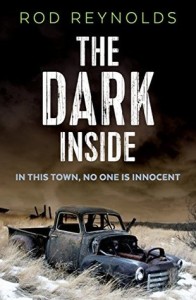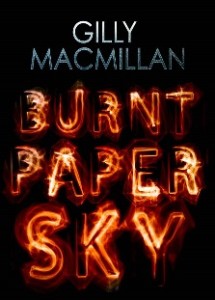

In the latest of my series of author to author articles and interviews (more to come very soon), I was delighted when the writer of my No 1 book of last year Rod Reynolds and the writer of one of my stand out reads of 2015 Gilly Macmillan agreed to have a little chat about their respective novels. Both The Dark Inside and Burnt Paper Sky have elements of journalism (in fact TDI has a journalist as the main protagonist) in their narratives but both are set in very different eras. So with an open question about the differences in news coverage between then and now, off they went and what followed was a fascinating back and forth that I just couldn’t bring myself to edit lest the flavour was lost! So enjoy and look out at the end for information on both books which if you havent read yet, you are definitely missing out on something fantastic!
Q: The press features significantly in both THE DARK INSIDE and BURNT PAPER SKY – but from very different eras. How do you think the press influences opinion today in the time of 24/7 news and internet as opposed to back in the times of typewriters and newspaper delivery boys?

GM: The first thing that springs to mind is the way in which press reports from a huge variety of different sources are instantly and widely accessible nowadays. We can step out of the door and purchase any number of print newspapers, and there’s an even greater choice of sources when we go online. This means that we can browse for our news, and be selective. We can check facts and, within hours of a story breaking, we might even be able to read an opinion piece on what’s happening. I think as a result of this wide and instant access to stories, we’ve become smarter and more picky about the news items that we read and what we learn from them, but also more demanding. The easy availability of information breeds a hunger for more stories, more facts, more information and we often want that as soon as possible.

RR: You’ve touched on a number of interesting points there. You’re absolutely right that news is now largely commercialised, and while that’s resulted in the evolution of 24/7 coverage, ‘live text’ digital updates, citizen journalism and more, I think the overall effect has largely been reductive and detracting. 24/7 channels have the airtime to cover a huge breadth of stories, in great depth – but the chase for eyeballs means ‘Headlines every 15 minutes’ on a seemingly endless loop. News as a business has produced niche channels with no pretense at all to objectivity – as epitomised by the likes of Fox News. Investigative reporting and in-depth articles have been sacrificed in the name of cheap, easy and quick. It’s news as fast food.
And yet that’s not even the most corrosive effect; that would be the rush to judgement that 24/7 news provokes. Stories hit the screen while they’re still unfolding; there’s no chance of any perspective. And your exploration of that was just one of the elements of BURNT PAPER SKY I found so intriguing…
GM: And in contrast, THE DARK INSIDE takes us back to a time when reporting was much more of a one-man job, and limited communications meant that information was more difficult to come by and disseminate. Your lead character, Charlie, perhaps through circumstances he might not have chosen, is nevertheless on a mission to investigate a crime, and he does this by personally meeting with and interviewing the people involved and following leads to the extent that he endangers himself. Do you think that kind of detailed, intelligent and brave investigating and reporting was a badge of honour for a good journalist back in the day, and do you think it exists now?
RR: I’m sure it was, just as I’m sure there are reporters who pride themselves on that kind of reporting these days; I think it’s just in shorter supply – and that’s not necessarily the fault of the journalists. It’s a totally different model now; at the time THE DARK INSIDE is set, the common practice was to have ‘legmen’ out on their beats, all the time, and they would simply call their stories in to the writers based back at the office. That obviously allows for much more freedom, and time spent ‘on the ground’. I’m sure there are reporters today who would kill for that model to return – but, as ever, economics dictates.
Equally, reporters are under so much more pressure now to provide continual coverage. Even at newspapers like the Telegraph, staff are expected to provide Twitter updates, pieces for the website that are updated throughout the day, and more, all alongside whatever they file for the print edition. BURNT PAPER SKY provides a fascinating look at how that model can, in turn, influence the case itself – and I thought in a very credible and authentic way. How did you go about researching that element of the book?
GM: It wasn’t easy or comfortable, but I researched that element of the book by paying close attention to real life cases of child disappearance, and watching how they unfolded via traditional and social media. There were two very high profile cases that happened while I was writing BURNT PAPER SKY and they both threw up slightly different reactions publicly, but what was common to both was how intense the reaction was online. There were extreme outpourings of sympathy and also extreme accusations made. People online clearly felt very emotional about the cases, and being able to interact over social media and discuss their feelings seemed to me to exacerbate that. Obviously there was some very reasonable response in both traditional and social media, but it wasn’t difficult for me to imagine how the people with more extreme reactions might translate their online outrage quite easily into unwelcome or dangerous action, which is explored in the plot of BURNT PAPER SKY.
I decided that I wanted to tell some of the story via traditional and social media extracts because that is how so many of us experience these cases in real life. I was hoping that, alongside the first person narratives of Rachel, the mother of the missing boy, and my detective DI Clemo, the media reports would give the novel a sort of documentary style so the reader not only has insight into the characters’ experiences but also learns about the case in exactly the same way they might normally, as a member of the public.
One of the things that intrigued me most as I was researching was how the social media reaction to the cases was often reported on in the traditional media (usually on days when there was little actual case progress to fill news bulletins), and this gave it a new authority, which in turn seemed to increase its intensity. In some cases search parties were organized via social media, and then word spread yet further by the reporting in news media, and while this was obviously very helpful to the investigations in some ways, I noticed that there were occasions when the police had to use their already limited resources to monitor, organize and sometimes limit what the public were doing. It made me wonder whether it’s a fine line between it being a help or a hindrance to an investigation when the public is mobilized via the media in this way.
I was fascinated by the relationship between the media and the police in THE DARK INSIDE. Your story is based on a true-life case and I wondered what sparked your interest in it in the first place, and what made you chose a journalist as your main character?
RR: I have a confession to make: I often dislike anything that deviates from the narrative, like diary inserts or news articles, because I sometimes find they pull me out of the story – BUT I genuinely loved the way you employed that technique in BURNT PAPER SKY. I think because the extracts and social media posts were so punchy and well-placed, they really did make it feel like the case was unfolding – and unraveling – in front of me. They ramped up the tension, and also illustrated so brilliantly the way these kinds of cases generate such polarised opinions. I thought it was a such a deft way of keeping an edge on your protagonist too – never quite letting the reader feel 100% sympathy for her, by showing us how the general public was reacting to her plight and the suspicion that lingered around her.
I stumbled over the true story that THE DARK INSIDE is based on, but as soon as I did, I was hooked and certain I wanted to write a novel about it (even to the point of immediately discarding the manuscript I’d been working on). There were so many elements of intrigue that sparked my imagination and, while the book is almost entirely fictionalised, many of the ideas it contains were inspired either by real life events, or the rumours and gossip that surrounded the case (or have sprung up in the years after).
Given where we started this discussion, I’d love to say I chose my protagonist to be a journalist because I wanted to say something about the importance of a free press and crusading reporting, but it was much more pragmatic than that: I just wasn’t interested in the procedural aspect of the investigation, plus wanted Charlie to be able to go anywhere and do anything that he felt would get him to the truth – in the way I didn’t think a police (or similar) character could credibly do. Also, I never wanted Charlie to be a tough guy, so I felt giving him a profession where he wouldn’t usually use his fists would leave him even more out of his depth when he pitched up in Texarkana.
Your next book looks to be, in some ways, quite different to BURNT PAPER SKY – how did that story come about?
GM My second book, THE PERFECT GIRL, is a little bit different from BURNT PAPER SKY in that it’s not a detective story in quite the same way (though watch this space for a sequel to BURNT PAPER SKY as Jim Clemo will return in Book 3). THE PERFECT GIRL has a much tighter and more claustrophobic time line – all the action takes place over just two days – and it explores how people can be pushed to the brink and how we can all make choices in just a split second that have the potential to profoundly affect the rest of our lives. Zoe, the character whose story is at the heart of THE PERFECT GIRL, is a teenage girl and a musical prodigy, and we meet her a couple of years after she caused the death of three other teenagers. She’s served her time and now she’s out and she’s preparing to give the performance of her life. Unfortunately, things don’t go as planned, and by midnight, her mother is dead.
I got the idea for Zoe after hearing, many years ago, about a case where a teenager was convicted and sent to jail for similar reasons. I just couldn’t forget about it and kept thinking about how an experience like that, at such a vulnerable age, might affect the rest of your life. Zoe’s story came from that idea initially, but then I began to think about how much we push our children in this day and age, and how much is expected of them, and I wanted to explore that too, hence I thought it might be even more interesting to explore how the story might develop if Zoe had a special talent of some kind, if she was, in the words of the blurb, ‘burdened by brilliance’ as well as the events of her past.
I would love to hear more about your next book. Am I right in thinking we’ll see the return of Charlie?
RR: It’s fascinating to me how ideas come to writers. There’s some romantic notion – I think I had it before I started writing seriously – that even if you have to wait a while, a good idea eventually just comes to you in the middle of the night, and then the story just flows onto the page. Of course, that’s not (usually!) the case, and it’s interesting that the basic idea for THE PERFECT GIRL stayed with you for a long time before you actually decided to write it. It was similar for me with THE DARK INSIDE, although the years it spent as a premise and a few notes in a drawer certainly gave time for the story to develop in my head.
My second book, which is titled BLACK NIGHT FALLING, was a bit different, in that although it’s a sequel and therefore the basis of the story naturally arose out of THE DARK INSIDE, I only really stumbled over the setting and background to the book while I was in America researching book one. There’s a town about 100 miles from Texarakana, called Hot Springs, which has a fascinating real life history, frequented as it was by the likes of Al Capone, Lucky Luciano and hordes of other famous gangsters over the decades. Gambling and prostitution, although nominally illegal, carried on right out in the open, and the place was rife with crime and corruption. It’s hard to imagine now, given the picturesque and peaceful little town it’s become, but the image of the place as it was in the 1940s immediately grabbed me, and I decided it would be a great scenario to have Charlie find himself in – especially given it’s proximity to Texarkana, the last place on earth he wants to be near.
Charlie is pressured into going to Hot Springs by an acquaintance from Texarkana, but things go bad as soon as he arrives, and he’s plunged into a nightmare of murder, deception and corruption. But the deeper he digs into it all, the more links he finds to his own recent past – and he soon realises the nightmare he’s been trying to outrun might not be done with him yet…
We’ve somehow got miles off topic, but it’s been great talking books with you. I think we should leave it there so you can crack on with book 3 – I know I can’t wait to hear more from Jim Clemo. Best of luck with the launch of THE PERFECT GIRL too, it sounds enthralling and I look forward to reading it!
GM: I love the title of your new book and I’m already intrigued by the new setting, which sounds amazing! I can’t wait to read it and get immersed in more of that fabulous and dark American Noir that you write so wonderfully well, and see what happens to Charlie. Very many thanks to you too.
Thank you both SO MUCH. And I can’t wait for The Perfect Girl and Black Night Falling either!
About the books:

Rachel Jenner turned her back for a moment. Now her eight-year-old son Ben is missing.
But what really happened that fateful afternoon?
Caught between her personal tragedy and a public who have turned against her, there is nobody left who Rachel can trust. But can the nation trust Rachel?
The clock is ticking to find Ben alive.
WHOSE SIDE ARE YOU ON?
You can Purchase Burnt Paper Sky HERE
Follow Gilly on Twitter HERE
My original review (and an interview with Gilly) can be found HERE.

1946, Texarkana: a town on the border of Texas and Arkansas. Disgraced New York reporter Charlie Yates has been sent to cover the story of a spate of brutal murders – young couples who’ve been slaughtered at a local date spot. Charlie finds himself drawn into the case by the beautiful and fiery Lizzie, sister to one of the victims, Alice – the only person to have survived the attacks and seen the killer up close.
But Charlie has his own demons to fight, and as he starts to dig into the murders he discovers that the people of Texarkana have secrets that they want kept hidden at all costs. Before long, Charlie discovers that powerful forces might be protecting the killer, and as he investigates further his pursuit of the truth could cost him more than his job…
You can purchase The Dark Inside HERE
Follow Rod on Twitter HERE
My original review (and an interview with Rod) can be found HERE
Happy Reading Folks!






Great work, as ever, Liz! Rod Reynolds got my debut of the year, but I reserved book of the year for Without The Moon by Cathi Unsworth (sorry, Rod!) Burnt Paper Sky was a good novel, but not, imho, as great as some people thought. For a debut, though, highly impressive. I’ll certainly buy The Perfect Girl – and book three – but I have to confess I’m really looking forward to Black Night Falling. Any idea when we can expect it, Rod, Liz?